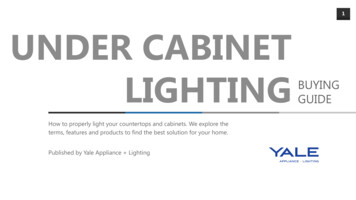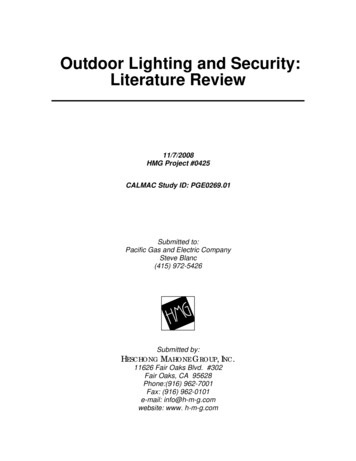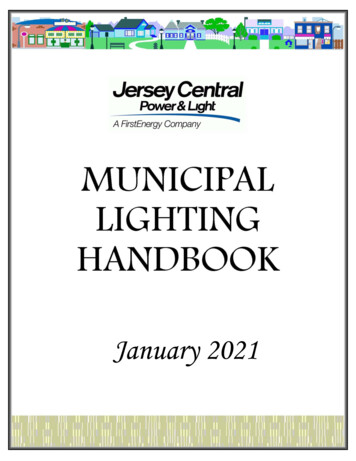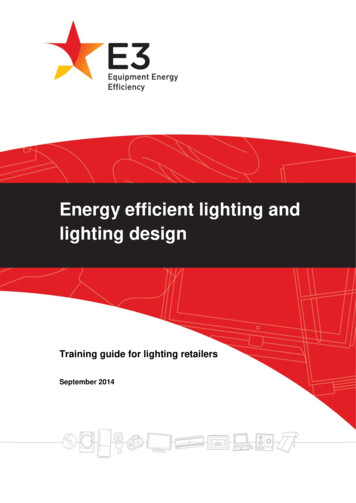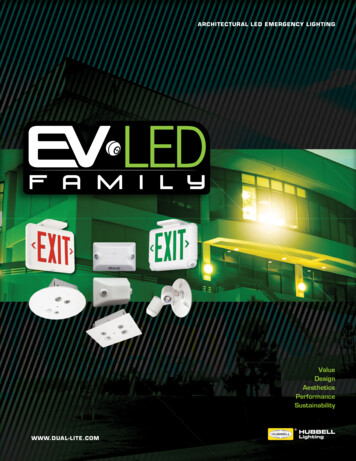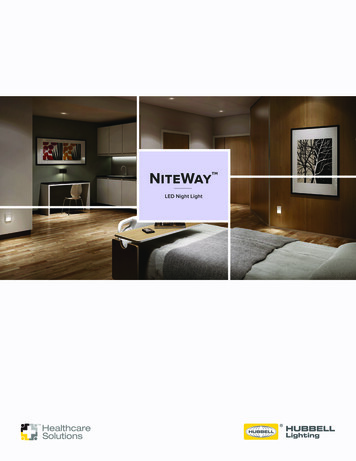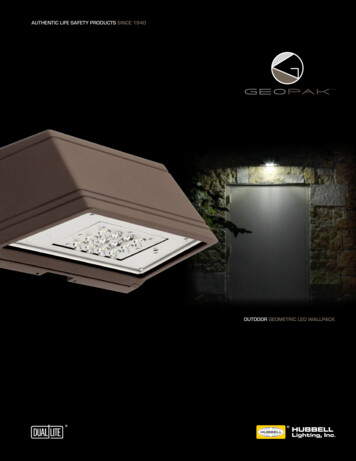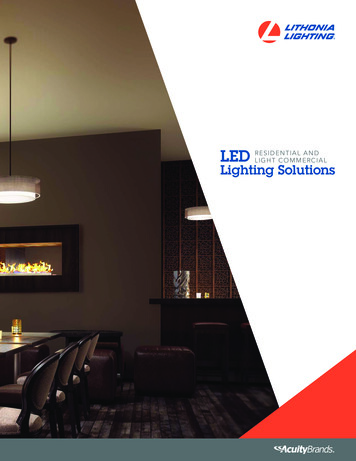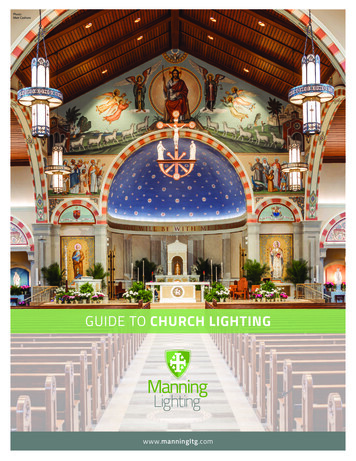
Transcription
Photo:Matt CashoreGUIDE TO CHURCH LIGHTINGwww.manningltg.com
7 tips for aSUCCESSFULCHURCHLIGHTINGproject.Get started with a lighting upgradeor new installation by understandingsome basics.1LOCATION, LOCATION, LOCATIONTwo important things to keep in mind: P osition fixtures over seating areas to makereading easier. S pace fixtures based on light coverage andthe spacing of windows, beams, and any otherarchitectural elements.Different Manning hangers and ceiling canopies are availableto accommodate sloped ceilings as well as cover bothrecessed and exposed outlet boxes for best appearance.2MOUNTING HEIGHTSuspend pendants so that the distance from floor tobottom of fixture is about 1.2 times the distance betweenfixtures (i.e. fixtures 10 feet apart should be 12 feet bovefloor). Generally, the higher a fixture is mounted, the moreeven the light distribution will be below.3FOCUS ATTENTIONSince the altar or chancel is the focal point ofmost churches, light levels here should be two tothree times greater than above the seating area.Manning adjustable spot and flood lighting unitsmounted behind an arch or beam can be used tolight the altar, pulpit, or other areas. Lighting thepulpit or lectern is best accomplished by at leasttwo units to minimize shadows.4DIRECT VS. INDIRECTThere are two basic ways to light your church:DIRECT FIXTURES use sophisticated reflector systems tolight the seating areas from above. INDIRECT FIXTURESbounce light up off the ceiling to light the area. Directfixtures are better suited for churches with dark interiorsand high ceilings. Indirect fixtures work best for white orlight woodinteriors andlower ceilings.Many Manningfixtures combineboth indirectand directlighting for theadvantagesof both.Bowl pendantsdirect light upwardsfor soft, comfortableillumination.Manning Spatialites mountedbehind a beam are a great wayto draw attention to areas,artwork, or people.www.manningltg.com PAGE 2
7 TIPS FOR A SUCCESSFUL CHURCH LIGHTING PROJECT ---continued5LIGHT LEVELSLight levels are measured in units called “footcandles,”with a level of 20 to 30 footcandles generally recommendedfor comfortable reading. Manning Lighting will work with youto ensure these levels are achieved by creating a detailedphotometric report and computer rendering of the newfixtures in your space. As important as the overall lightlevels, is the distribution of light in the space.BEFOREA uniform amount of light, without bright spots underfixtures or shadows between them, is the goal.Another goal is the ability to control light levels in differentparts of the church at different times to highlight a speaker,a choir, or a ceremony. That’s why Manning fixtures arecompatible with a wide variety of dimming controls, fromsophisticated theatrical systems to simple wall dimmers.AFTERREPLACING older fixtures withnew ones led to dramaticallyhigher light levels and energyefficiency at St. ColumbanusChurch in Blooming Prairie, MN.6BE EFFICIENTCan church lighting be effective and energy efficient?Yes! But not all types of lighting sources are appropriate forecclesiastical spaces. F ixtures designed with incandescent lamps in mind maystill be a viable option because they are inexpensive, canbe dimmed easily, and need little in the way of specialequipment to operate and maintain. However, becausethey are inefficient and have relatively short lamp life(generally 2000 hours or less), they aren’t a good choicefor many types of spaces. Screw-in LED bulbs are nowwidely available as incandescent replacements, andprovide benefits in terms of energy savings and life.However, their overall quality, color, and performancewhen being dimmed varies. Purpose-built LED light engines offer much betterefficiency and longer life than screw-in LED bulbs.They also are designed to provide better, more evenillumination and be compatible with a variety of dimmingsystems. Manning Lighting has many of these dedicatedLED solutions available across its product line. See the“LED FAQ” in this Guide for more information on LED.www.manningltg.com PAGE 37NEW OR RETROFIT?Churches considering a lighting upgrade often have adifficult decision to make: Should exisitng fixtures stay or arenew ones a better choice? Start by answering a few questions: How attached is the congregation to the existingfixture design? What is the condition of the items? What is your budget? (Refurbishing old or badlydamaged fixtures is often more expensive thanpurchasing new ones.) Is more light a priority, or is simply renewing thefixture appearance sufficient?From there, we can give you ideas and estimates on bothnew and retrofit options. And sometimes a combination ofretrofitted fixtures andnew lighting types is theright answer. Either way,Manning Lighting can doeverything from a simplecleaning and rewiring, toa full-blown refurbishmentwith a state-of-the-artLED system.
THE FAQSON LEDNEW TO LED LIGHTING?These fresquently asked questionsand answers below will give yousome information about LEDtechnology and its benefits.HOW DOES LED LIGHTING WORK? We’ll spare you the technicaldetails here: Think of an LED as a tiny light bulb that lives on acircuit board. A power supply called an LED driver is necessaryto convert standard line voltage to the low voltage that thecircuit board requires.WHAT ARE THE BENEFITS OF LED VS. CONVENTIONALLIGHTING? Lower energy costs, and reduced maintenance. Forexample, an incandescent fixture that uses 1500 watts can bereplaced with an equivalent LED model that uses 150 watts.Plus, the LED components are rated to last 50,000 hours beforereplacement is required. That’s decades for most churches!ARE THERE ANY DOWNSIDES TO LED TECHNOLOGY? I nitial cost is higher. C are must be taken to ensure compatibilitywith dimming systems.WHAT KIND OF LEDS DOES MANNING LIGHTING OFFER?We offer different LED types depending on the fixture shape,size, and lighting requirements. Sconces use LED boards,while pendants use both boards and LED downlight or uplightmodules. We use only high quality LED components from provenmanufacturers including Cree, Osram, and Lutron.WHAT ABOUT DIMMING? LEDs can dim very well if they areconnected to the proper dimming controls. Manning fixturesare compatible with most systems, including incandescentdimmers (also called leading edge or Triac), electronic lowvoltage dimmers (also called trailing edge or ELV), and 0-10vdimmers (also called fluorescent). Theatrical controls such asDMX are also an option.Whichever system is used, we recommend you proceed withcaution. Most dimmers have a maximum LED load that can beapplied, often as little as 10% of its nominally rated value. Sinceit’s impossible to test every LED option with every dimmer type,it is advisable to test a particular fixture with a specific dimmerbeforehand to ensure that the combination will work as expected.WHAT ELSE SHOULD I KNOW? LEDs don’t burn out likeregular sources. Instead, they gradually grow dimmer over time.LED longevity is typically rated as the time it takes until their lightoutput is reduced to 70% (or L70). Our components are rated tohave an L70 of 50,000 hours or more.IS LED LIGHTING EXPENSIVE? LED equipment costs morethan incandescent, fluorescent or other sources. However, whenyou factor in savings in energy, maintenance, initial cost of lamps,and dimming controls, LEDs will always have a relatively shortpayback time to recoup the initial cost.CAN I UPGRADE MY OLDER MANNING FIXTURES TO LED? Yes. Our fixtures have always been designed with a modular approach, so replacing incandescent, fluorescent, or other sources with LED can be very cost-effective. Even fixtures notoriginally made by Manning Lighting can usually be upgraded to LED.WHAT’S THE DIFFERENCE BETWEEN A RETROFIT LED LIGHT ENGINE FROM MANNINGLIGHTING AND BUYING SCREW-IN LED LIGHT BULBS FROM A LOCAL HARDWARE STORE? Higher Maintenance Costs: Screw-in bulbs have a shorter rated lifethan dedicated boards and modules (usually less than half as long). Lower Light Levels: Bulbs don’t provide nearly as much light asdedicated LED downlight modules. Spotty performance: Bulbs don’t illuminate the acrylic or glassdiffuser panels of the fixture as evenly as LEDs. Color: The color temperature of LED bulbs ranges from warmto cool – even among bulbs from the same manufacturer.Color consistency, and the ability to accurately show the colorsof your church—the wood, the artwork, and even the people,is much better with dedicated LEDs. After all, who wants tosee a green bride?INCANDESCENT BULB:Watts: 500Lumens: 6500Life: 2000 hours (or abouttwo years if used 20 hrs./week)CONTACT US TODAY TO LEARN HOW YOUR CHURCH CAN BENEFIT FROM LED!www.manningltg.com PAGE 4MANNING LED:Watts: 96Lumens: 9,937Life: 50,000 hours (or about48 years if used 20 hrs./week)920.458.2184
P ROD UCTOVERVIEWGOTHICTRANSITIONALMANNING LIGHTING’S STANDARD PRODUCT LINE offers dozens of fixture styles, each available in several sizesand illumination options. To see all Manning products, including new items and the latest LED technology,visit us at www.manningltg.com.TUDOR GOTHICNEW ENGLANDGOTHICFRENCH GOTHICENGLISH UHAUSPRAIRIEROMANMILANCOLUMN 4BARCOLUMN RAILCOLUMN BLANKOMEGAPLINTH ROUNDPLINTH SQUAREZURICHKIOSK ROUNDVIANNEMEDDLEKIOSK SQUAREH.O.OHREOHEIGHTROSYTRADITIONCORNICEFLEUR DLELEMENTSDISCOHPLANAREach Manningfixture styleincludes matchingpendants, wallsconces, andceiling fixtures.OMEGASOLNUVILLE CORNICEFLEUR CHANDELIERSCHOOLHOUSEPENDANTWALL DELIERCEILING FIXTUREwww.manningltg.com PAGE 5
MANNING LIGHTING WAS FOUNDEDIN 1948 AS A CUSTOM DESIGNER ANDMANUFACTURER OF TRADITIONALAND CONTEMPORARY DECORATIVELIGHTING FOR RELIGIOUS BUILDINGS.Today Manning Lighting remains family-owned andoffers a complete line of products for commercialand institutional architectural spaces in additionto an extensive line of church lighting for alldenominations and budgets.Copyright 2015LS3P Associates comPO Box 1063, Sheboygan, WI 53082
even the light distribution will be below. 4 DIRECT VS. INDIRECT There are two basic ways to light your church: DIRECT FIXTURES use sophisticated reflector systems to light the seating areas from above. INDIRECT FIXTURES bounce light up off the ceiling to light the area. Direct fi




